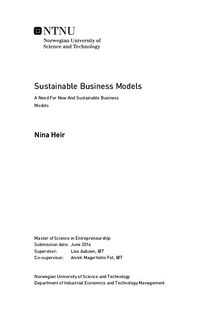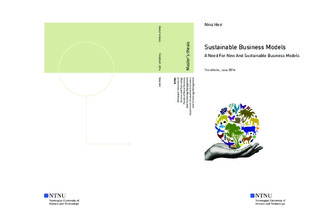| dc.description.abstract | Business plays a key role for the sustainable development of the society. However, business models of today do not have a sustainable perspective, indicating that they do not balance the three dimensions of sustainability; the social, environmental and economical dimension. A change at the business model level is therefore required for sustainable business models to become the new business models of tomorrow.
The purpose of this study is to increase the knowledge of how companies can contribute to a sustainable development through the creation of value related to the three dimensions of sustainability. Furthermore, it is a wish that this study shall increase the knowledge of which sustainable elements the selected case companies are working with, and to which parts of the business model these elements can be related to. This study also seeks to uncover the relationship between the company's strategic plans for sustainability and the actual integration of sustainable elements. Two research questions are proposed to answer to the purpose of the study.
Examples of sustainable elements are waste management, change from fossil fuels to renewable sources of energy, recycling and reuse, to secure safe working conditions, reduce harmful emission and use of eco-friendly materials.
A literature review was conducted by Ronæss and Heir (2016) presenting a theoretical fundament which has been integrated as a part of the conceptual background for this master s thesis. The theoretical fundament consists of theory related to the fields of business models, business model innovation and sustainable business models. It is revealed to be little consistency regarding a common definition both for business models, business model innovation and for the relatively new area of research; sustainable business models. This implies a lack of theory, and uncovers a demand for more research related to these fields. The framework the business model canvas (BMC) is introduced in the conceptual background, and if further used as a framework for the analysis in this study.
The purpose of this thesis is fulfilled through a multiple case study approach, where information from case studies of six selected companies is used to acquire in-depth knowledge for the analysis. The empirical findings are analysed in relation to the research questions, before the result of the analysis is discussed to which degree they answers to the research questions and the overall purpose of this study. The last part of the discussion relates the analysis to the challenges presented in the introduction.
Six goods-producing companies are investigated through the case studies, one of which also provides services related to waste management in the Norwegian industry. The Norwegian companies Plasto, Hexagon Ragasco and Wonderland are included in this master s thesis, all of which are part of the research project SISVI at NTNU. Additionally, the Norwegian companies Elkem, Norsk Gjenvinning and the Swedish company IKEA are included.
The analysis shows that the integrated sustainable elements in the companies business models can mainly be related to three parts of the business model. It is also uncovered that integration of sustainable elements at the business model level can be challenging to measure. Through the analysis it is revealed that the relation between what the companies wants to do and what they are actually doing are related in a varying degree. Plans at the strategic level without being rooted in a plan of action do not prove to contribute to actual integration of sustainable elements. What has become clear is that the companies' commitment and focus on sustainability contributes to influence the industry, politicians and the society, and might contribute to increased facilitation, more incentive programs and more regulations concerning sustainable development.
This leads to a discussion of the various integrated elements, and whether one can say something about the extent of integration and the importance of which parts of the business model the elements are related to. In addition, is the relationship between the companies' plans and actual integration of sustainability discussed, including the forces influencing how the company works with sustainable development. It is also discussed whether the integration of sustainable elements into a company's business model proves to contribute to sustainable development in the society, if the company balances the three dimensions of sustainability. The discussion touches upon if the integration of sustainability can have a positive synergistic effect on the companies financial performance. A greater degree of integration is probably associated with an increased performance in the long run.
This study sets out to shed light on the importance of the fact that the research area of sustainable business models should be explored furtehr in the future. In addition, the author encourage that further research should look into the order of which the sustainable elements are integrated in, the integrated extent of each element, and if the integration of sustainability can have a positive impact on the company s financial performance. In this way, the research might contribute to the development of new and sustainable business models that can be used in practice, addressing the three dimensions of sustainability. | |

